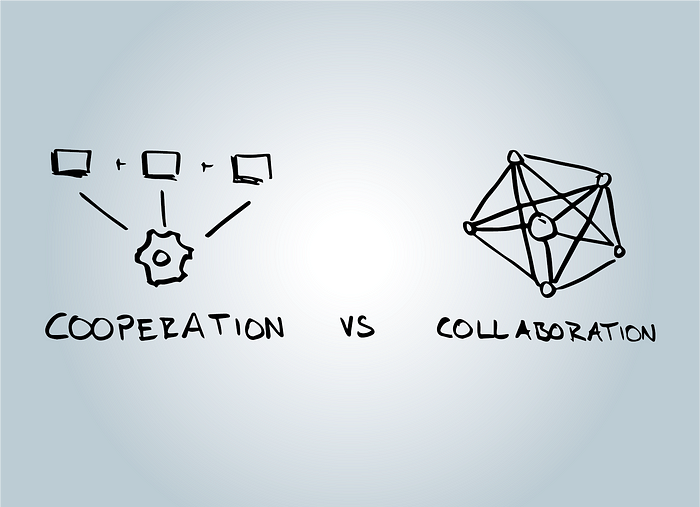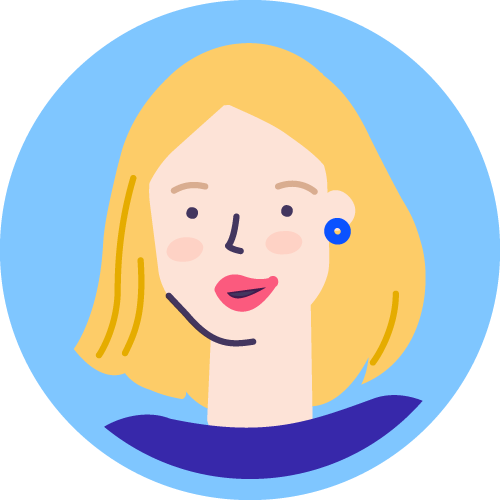The importance of collaboration in product discovery (and how to get it right)
A lot has been written about methods and tools for product discovery (i.e. how to understand user problems and solve them). And, while a lot of it is great, I’ve realized that the most difficult part of discovery is how to do it collaboratively.
I briefly talked about collaborative discovery in a previous article, but now I want to dive deeper as I don’t think it’s discussed enough.
For me, ‘collaboration’ is about a multi-skilled team working together synchronously, or in a coordinated manner, to complete a task in support of a shared objective.
As such it differs from ‘cooperation’ where group members are assigned a portion of the problem and support each other to achieve their individual sub-goal.

With my teams at NavVis (a robotics and VR start-up), Babbel (a language learning scale-up), and now Saiga (an AI personal assistant start-up), I’ve tried a number of different collaboration models and setups. Some worked well. Others not at all.
Inspired by those learnings, the below is a practical guide on how the functions of product design, product management, and engineering can collaborate effectively in product discovery.
Why collaboration is key to successful product discovery
There was a time when individuals would run (parts of) the product discovery process by themselves. In the not-so-good old waterfall days, a business person and a designer (engineering was rarely involved) would drive discovery. Not collaboratively, but strictly sequentially and cooperatively.
While less discussion and coordination was required, this process had several shortcomings:
- Blockers were discovered too late down the road (e.g. a designer’s proposed solution was impossible to implement).
- Critical information got lost as there was misunderstanding between the designer and business person.
- A continuous process of counter-correcting (which is key to getting things right!) was almost impossible as everyone was focused on their own phase of the process.
These shortcomings created worse outcomes (or sometimes no outcome at all because concepts could not be implemented), which is why agile methodologies (which promoted cross-functional and collaborative teamwork) gained such popularity. They were developed on the belief that collaboration is King, Queen, and Kingdom.
If you want to build truly outstanding products that are feasible, valuable, viable, and valuable at the same time collaboration is essential.
BUT! Real collaboration is real hard. Here’s why…
1. Product discovery is usually not a linear process that leads to a final solution.
On paper, most companies try to follow a process like this👇

You discover a problem that fits a business outcome. You narrow down the problem, then go broad to brainstorm and test multiple solutions. Finally, you settle on one solution, designing the concept and interfaces in all their detail.
That’s the dream, but in reality you often jump back and forth between these stages and rather end up with something that looks like this (ok not always that bad, but you know what I mean)👇

Product discovery is a continuous process of unpredictable counter-correcting. This can be frustrating for one individual to navigate, let alone a whole team. You can see why people may opt for a more efficient siloed approach.
2. Product discovery is a multi-lane road.
You can never predict the outcome of your discovery initiatives, and there’s always the possibility that you have to end an initiative because your proposed customer problem is not severe enough.
(In fact, teams that never end the exploration of an initiative are probably not doing the brave and open-minded discovery they think they are.)
Given things might end early, it’s usually wise to pursue multiple initiatives at the same time. This is already mentally difficult for an individual. For a whole team, it’s even more challenging and costly.

3. Product discovery is an art as much as a science.
High-performing product teams try to work as scientifically as possible. Problem and solution hypotheses are validated based on data, before things are moved into delivery.
However, it’s usually impossible to guarantee that something is 100% the right problem and 100% the best solution before the respective piece of software is shipped. Experiments to validate concepts are really only proxies for the real solution. As much as we want to make data-driven decisions, personal intuition plays a crucial role.
This is where collaboration becomes tricky and leads to lengthy discussions. Different team members will have different feelings on where they think discovery needs to head.
6 ways to overcome these challenges and collaborate effectively
1. Establish a product trio within your product development team/squad that drives all discovery decision-making.
A product trio consists of a product designer, product manager, and a lead engineer. Together they drive all discovery efforts forward and represent different functional expertises — ensuring developed-concepts are feasible, viable, valuable, and usable.
The rest of your team still contributes to discovery, but in a light-touch manner.

This setup allows you to take different perspectives into consideration. It reveals blockers early on and — as the decision-making team is fairly small — gives you the flexibility to make quick turns in a non-linear process.
Note: for more detail on the product trio setup, read this article and this one by Teresa Torres.
2. Stay flexible in your roles.
Good product discovery is like playing on a sports team.
In my basketball team, I’m a center player who’s expected to be good at catching rebounds. I can’t be everywhere though. Our point guard may be in a better position to take the rebound.
Similarly, while a product trio consists of different expertises, each person should still be encouraged to think and act holistically.
An engineer should challenge the viability of a solution even if it was proposed by the product manager who is considered the business expert. And a product manager should be fine with building a low-fi prototype when the designer is on vacation and an initiative needs to move forward.
3. Hire people without a big ego.
Product discovery should be about your users. Not your team and whose idea or opinion wins.
As mentioned above, the product trio has to use their intuition and gut feeling to take best-guess decisions. Those with big egos often struggle to accept this if an opinion contradicts their own. They won’t fully commit to the work quickly.
People with big egos harm a customer-centric and collaborative work culture. To avoid them, check for collaboration skills during your hiring process. Ask questions like “What did you do the last time when you and your PM/PD/Eng colleagues disagreed about a concept and you didn’t have any data to support the decision making?” to understand whether someone is a collaborator at heart or not.
4. Establish a common language.
Different disciplines have different lingo. But, to ensure proper collaboration, people need to understand each other. Here are two things that help make this work…
a) Establish a culture where asking someone to explain a term is perfectly normal.
You can encourage this by setting up a glossary where you add all those terms that not everybody might know. Working on a machine learning (ML) product at Saiga, we have a number of technical ML terms that we define in a glossary. We also run sessions where our Head of Engineering explains our database setup and the terminology around it, to product managers and product designers.
b) Stop talking and start drawing.
A picture paints a thousand words. Shared understanding is often more easily derived from drawing a sketch than from talking through an idea.

Lengthy discussions usually always reach a point where someone says, ‘how about we quickly visualize what we mean?’ Ask that question earlier to save yourself time.
5. Talk to users, ideate solutions, and take decisions together.
Collaboration does NOT mean doing each and every activity together as a team. You don’t have to read an API documentation together to validate feasibility. And you don’t have to sit in front of one screen to build a detailed click-through prototype together.
To be efficient, product trios need to divide and conquer, only bringing together people when they’ll really make a difference. Based on my experience, here are three occasions when they might do that…
a) When you talk to users. Hearing a person talk is quite different from reading quotes later. It creates a shared understanding of your customers.
b) When you ideate solutions. The beauty of brainstorming together is that people can build upon the ideas of others. The most creative ideas usually come from group ideations, not from a single person having an ingenious idea sitting lonely at their desk.
c) When you make decisions. Effective collaboration requires everyone to buy into important decisions. The easiest way to achieve this is to make decisions together. This way, everyone feels heard and all required perspectives are considered.
Pro tip: at Saiga, to make sure these get-togethers happen we don’t just rely on ad-hoc discovery meetings. We’ve established a couple of regular meetings to foster collaboration. For example: product trio dailies, weekly discovery meetings, and fixed user interview slots that the whole product trio (if possible) attends.
6. Have a single source of truth where all discovery work is documented.
Throughout discovery, it’s crucial to centrally document decisions and progress. This gives everyone an overview to work from and the latest insights to build on.
At Saiga we haven’t really found the golden tool yet. However, as long as we’re disciplined enough to keep things up to date, a simple Notion section works well.
We have a board where we track opportunities and solutions along with the different phases of our discovery process. Each ticket on the board describes an initiative including the problem, the concerned user, how the problem links to our objectives, underlying assumptions, and of course links to all tools where the solution is sketched out (in our case, Figma and our copy docs).
Final thoughts
Collaborative and cross-functional teamwork is hard.
You need to lay the right foundations to make it happen, and then continue to adapt, adjust, and improve every day. I hope the above ideas help you do this.
Got your own collaboration tips and tricks that have worked well? Feel free to share in the comments below!
As always, thanks Ben for your fantastic help with editing this article 🙏
